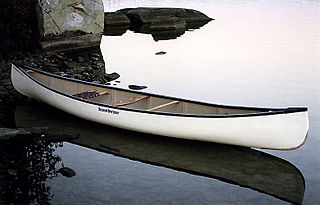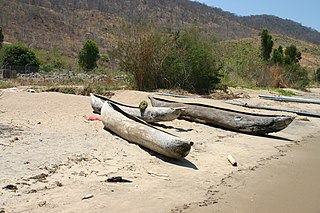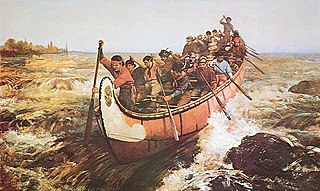 W
WA canoe is a lightweight narrow vessel, typically pointed at both ends and open on top, propelled by one or more seated or kneeling paddlers facing the direction of travel and using a single-bladed paddle.
 W
WBirau, is a type of small dugout canoe of the Sama-Bajau people of the Philippines. They are made from a single log hollowed into a canoe with a rounded bottom. The prow and stern of the vessel usually has knob-like protrusions. A smaller wider variant without these knobs is known as bitok. Birau are usually around 1.5 to 4.5 m long. They are sometimes equipped with two outrigger floats. They are very similar to the buggoh, differing only in that the prow and the stern of the birau slope inward.
 W
WBuggoh is a type of small dugout canoe of the Sama-Bajau people of the Philippines. They are made from a single log hollowed into a canoe with a rounded bottom. It is equal-ended, with the prow and the stern dropping straight down or sloping outward. They are sometimes equipped with two outrigger floats. They are usually around 1.5 to 4.5 m long. It is also known by various other names, including boggo', buggoh jungalan, buggoh-buggoh, or beggong.
 W
WCanadian is the byname used in some countries for the descendants of the birch bark canoe that was used by the indigenous peoples of Northern America as a convenient means of transportation in the densely forested and impassable areas of Northern America.
 W
WLa Chasse-galerie also known as "The Bewitched Canoe" or "The Flying Canoe" is a popular French-Canadian tale of Coureurs des bois who make a deal with the devil, a variant of the Wild Hunt. Its best-known version was written by Honoré Beaugrand (1848–1906). It was published in The Century Magazine in August 1892.
 W
WChundan vallam, known outside Kerala as Kerala snake boats, are one of the icons of Kerala culture used in the Vallamkali or boat race.
 W
WThe Combined Military Services Museum in Maldon, Essex houses the only surviving original Cockle Mark II canoe used by the Royal Marine Raiders on Operation Frankton, commonly known as the Cockleshell Heroes. The canoe is believed to be ‘Cachalot’ damaged during the launching of the canoes from the submarine, and returned to the Saro Works boat yard on the Isle of Wight for repair. However, production of the canoe had moved to Parkstone Joinery in Dorset, and so the canoe was never repaired. The Canoe was restored by the museum, using original plans and sketches made by the designer Goatley, and the raid commander Halser. Copies of some of this paperwork can be viewed alongside the canoe.
 W
WA concrete canoe is a canoe made of concrete, typically created for an engineering competition.
 W
WThe dalca or piragua is a type of canoe employed by the Chonos, a nomadic indigenous people of southern Chile. It was a light boat and ideal for navigating local waterways, including between islands of the Chiloé Archipelago, through the Chacao Channel to mainland Chile, and along the coast of the Gulf of Penas. Spanish chronicles called it best-suited for those waters, far superior to ships of the conquistadores.
 W
WDjenging is a type of large double-outrigger plank boat built by the Sama-Bajau people of the Philippines. It is typically used as a houseboat, though it can be converted to a sailing ship. It was the original type of houseboat used by the Sama-Bajau before it was largely replaced by the lepa after World War II. Larger versions of djenging were also known as balutu or kubu, often elaborately carved with bifurcated extensions on the prow and stern.
 W
WA dugout canoe or simply dugout is a boat made from a hollowed tree. Other names for this type of boat are logboat and monoxylon. Monoxylon (μονόξυλον) is Greek -- mono- (single) + ξύλον xylon (tree) -- and is mostly used in classic Greek texts. In German, they are called Einbaum. Some, but not all, pirogues are also constructed in this manner.
 W
WThe Etolin Canoe is an unfinished dugout canoe on Etolin Island, in the Tongass National Forest, that is listed on the U.S. National Register of Historic Places. It is made of a single Western red cedar or an Alaska yellow cedar trunk and was started, it is believed, somewhere between 1880 and 1920.
 W
WThe Haskell canoe was a boat built by the Haskell Boat Company in Ludington, Michigan. It was made with a single sheet of three-ply lightweight waterproof plywood. It was marketed throughout the United States and Canada. Peak production of the canoe occurred during the 1920s. The length was extended in 1930 and by 1934 it was no longer made.
 W
WThe Hjortspring boat is a vessel designed as a large canoe, from the Scandinavian Pre-Roman Iron Age. It was built circa 400–300 BCE. The hull and remains were rediscovered and excavated in 1921–1922 from the bog of Hjortspring Mose on the island of Als in Sønderjylland, southern Denmark. The boat is the oldest find of a wooden plank ship in Scandinavia and it closely resembles the thousands of petroglyph images of Nordic Bronze Age ships found throughout Scandinavia. The vessel is a clinker-built wooden boat of more than 19 metres length overall, 13.6 metres long inside, and 2 metres wide. Ten thwarts that could have served as seats, span the boat with room for two persons each; this suggests space for a crew of at least 20 who propelled the boat with paddles. The boat would have weighed an estimated 530 kilograms (1,168 lb), making it easily portable by its crew.
 W
WThe International Canoe (IC) is a powerful and extremely fast single-handed sailing canoe whose rules are governed by the International Canoe Federation.
 W
WJelav is a village in the municipality of Loznica, Serbia. According to the 2011 census, the village has a population of 854.
 W
WJunkun, is a type of small dugout canoe of the Sama-Bajau people of the Philippines. They are usually made from a single log, though a single plank can be added to the sides, and longer boats can include ribs that support a deck made of planks. They are around 2.5 to 8 m long. They have knob-like protrusions on the tip of the prow and the stern, which also sweep upwards from the waterline. They are sometimes equipped with double outriggers. They are used for fishing and short-distance travel.
 W
WA mashoof, also transliterated mashuf, is a long and narrow canoe traditionally used on the Mesopotamian Marshes and rivers of southern Iraq. It was widely used by the Marsh Arabs, or Maʻdān (معدان), as a fishing boat, water taxi, and primary means of transportation for people and goods. The mashoof's skinniness makes it an ideal vessel for navigating between the reeds and grasses of the marshes.
 W
WA mokoro is a type of canoe commonly used in the Okavango Delta and on the Chobe River in Botswana. It is propelled through the shallow waters of the delta or the river by standing in the stern and pushing with a pole, in the same manner as punting.
 W
WNouka Baich is a traditional dragon boat-style rowing sport of Bangladesh. The Bangladesh Rowing Federation, established in 1974, is the authority of all rowing activities in Bangladesh and has organised over 40 National Rowing Championships. The races are held during the wet and autumn seasons of the Bengali calendar which corresponds from June to October in the Gregorian calendar. The "Nowka Bais" which takes place annually in Birmingham is a leading cultural event in the West Midlands, United Kingdom attracting not only the Bangladeshi diaspora but a variety of cultures. It is also the largest kind of boat race in the United Kingdom.
 W
WThe Pesse canoe is believed to be the world's oldest known boat, and certainly the oldest known canoe. Carbon dating indicates that the boat was constructed during the early mesolithic period between 8040 BCE and 7510 BCE. It is now in the Drents Museum in Assen, Netherlands.
 W
WA pump boat is an outrigger canoe (bangka) powered by a small gasoline or diesel engine. Smaller pump boats might be powered by the sort of small single-cylinder engine used to drive a water pump. Larger ones are often powered by recycled automobile engines.
 W
WA rabaska or Maître canoe was originally a large canoe made of tree bark, used by the Algonquin people.
 W
WSakman, better known in western sources as flying proas, are traditional sailing outrigger boats of the Chamorro people of the Northern Marianas. They are characterized by a single outrigger and a crab claw sail. They are the largest native sailing ships (ladjak) of the Chamorro people. Followed by the slightly smaller lelek and the medium-sized duding. They are similar to other traditional sailing ships of Micronesia, like the wa, baurua, and the walap. These ships were once used for trade and transportation between islands.
 W
WA sprint canoe is a canoe used in International Canoe Federation canoe sprint. It is an open boat propelled by one, two or four paddlers from a kneeling position, using single-bladed paddles. The difficulty of balance can depend on how wide or narrow the canoe is, although regularly the less contact a canoe has with the water the faster it goes. This makes the narrower boats much faster and popular when it comes to racing.
 W
WTilikum was a 38-foot (12 m) dugout canoe that was used in an effort to circumnavigate the globe starting in 1901. The boat was a "Nootkan" (Nuu-chah-nulth) canoe which was already old when she was obtained by captain John Voss in April 1901. The boat was built in the early 19th century as a dugout canoe made from a large red cedar log. Tilikum was purchased for $80 in silver from a native woman in a transference ceremony allegedly sealed by a bottle of rye whiskey - the name Tilikum means "friend" in Chinook jargon. Apparently, John Voss and his companion in this venture, Norman Luxton, were inspired by the voyage of Joshua Slocum, who sailed the 37-foot (11 m) sloop Spray around the world a few years earlier and wrote a best selling book about his adventures.
 W
WThe vinta is a traditional outrigger boat from the Philippine island of Mindanao. The boats are made by Sama-Bajau, Tausug and Yakan peoples living in the Sulu Archipelago, Zamboanga peninsula, and southern Mindanao. Vinta are characterized by their colorful rectangular lug sails (bukay) and bifurcated prows and sterns, which resemble the gaping mouth of a crocodile. Vinta are used as fishing vessels, cargo ships, and houseboats. Smaller undecorated versions of the vinta used for fishing are known as tondaan.
 W
WWa are traditional sailing outrigger canoes of the Caroline Islands. They have a single outrigger. They are similar to the sakman of the Northern Marianas.
 W
WThe Waherak Maihar is a historic outrigger canoe on the island of Saipan in the Northern Mariana Islands. Built in 1958, it is a well-preserved example of a traditional Caroline Islands ocean-going canoe. It is 26 feet (7.9 m) long with a beam of 3 feet (0.91 m). It was constructed by the islanders of Poluwat from native materials, including coconut, pandanus, and breadfruit.
 W
WA war canoe is a watercraft of the canoe type designed and outfitted for warfare, and which is found in various forms in many world cultures. In modern times, such designs have become adapted as a sport, and "war canoe" can mean a type of flatwater racing canoe.